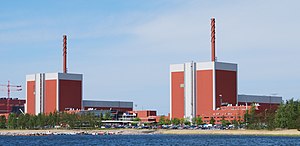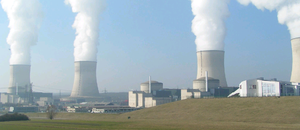| Olkiluoto Nuclear Power Plants 1 & 2 (BWRs with 860 MWe each) in Eurajoki, Finland. Suomi. (Photo credit: Wikipedia) |
| The control room at a U.S. nuclear power plant. (Photo credit: Wikipedia) |
| Ikata Nuclear Power Plant (Photo credit: Wikipedia) |
| Nuclear power plant in Cattenom, France (Photo credit: Wikipedia) |
| Nuclear Power (Photo credit: EnvironmentBlog) |
| The CANDU Bruce Nuclear Generating Station is the second largest nuclear power plant in the world. (Photo credit: Wikipedia) |
It never ceases to amaze me that people who seem to be
perfectly normal, well adjusted and in most things well informed, can still
make fallacious arguments about subjects which, to me, have been perfectly
clear for decades.
One of these subjects is nuclear power; another is
abortion. Both are subjects of intense controversy around the world, but still
many decades after I considered the arguments were over and my side had won,
the arguments rage on.
Let me take them in sequence: last night I went to a
screening at the admirable Cinema Politica series at Concordia University here
in Montreal of two documentary films dealing with nuclear power. The generic
title of the evening was “Women of Fukushima”, and the evidence brought on the
subject of Japan having 54 nuclear power stations, in spite of having
experienced the bombs on Hiroshima and Nagasaki, was devastatingly clear. One
woman, who had been for years an ordinary, non-political housewife, put it as
simply as it can be put when she said:
“What is important? There are three things: life, health and the care of
children. What else is there? Yet they have built these things…. Money is not
the only thing that is important…”
As far as she was concerned, nuclear power came down to a
question of money, to people giving the primacy to money over all other life
values.
It was striking that while to the outside world the
tsunami caused the bigger devastation, to these women the meltdown of the nuclear
power plant appeared incomparably more important, to the degree that the
tsunami was not even mentioned in the film.
I understand how this could be so. It may seem to the
engineers who have made all these nuclear plants that theirs is a fool-proof
method of generating electric power, but what it really amounts to is that
these engineers on our behalf have entered into a Faustian bargain: all that is
needed is for one of these nuclear
plants to seriously malfunction, and devastation occurs that covers a huge area
of country, affects millions of people and lasts for years and years, because
it is impossible to clean up. They have, in other words, sold our souls to the
Devil, “our” meaning the populations of the world, and we have to pay in
suffering when time comes to cash in their
Faustian bet.
There is no other disaster comparable to this: it
continues apparently almost for ever; it strikes into our very processes that
keep us living, transforming and mutating us by the thousands, and expelling
us from areas in which the radiation from the meltdown holds sway, apparently
into the indefinite future.
That these are the facts is attested to by a strange
circumstance, that nuclear power stations are built in spite of the fact that private
insurance companies will not insure them ---
that is left for the government to do, or to make some kind of guarantee
about, since the costs of a major nuclear accident are so gigantic that no
budget on earth could sustain them.
The meltdown at Fukushima occurred on March 11, 2011 ---
more than two and a half years ago --- and the latest word is that the damage
will not be cleared up for 40 years, surely just a guess. No one is allowed
into an area 20 miles square, and although people who had lived here, been born
there even, still hanker to go back, they know it would be at the cost of their
own health and longevity. The first of these two films showed a woman working
over some vegetables, and saying, “We used to be able to grow clean, edible
vegetables. But now, all the vegetables we grow are affected by radiation.” And, as everyone knows, radiation can be fatal for humans or other forms of life.
The second film --- both were made by Americans, it seems
--- show how Japan, which had once been an active country with lots of public
protests, had since the 1960s sunk into a state of apathy before government and
corporate manipulation. In the area most closely affected by the nuclear
meltdown, for generations they had never been able to get more than 100 people
to a street demonstration against anything. With solid intellectual support
from various professors, researchers and others, a group of younger people, some
of whom had formed their own bands, decided to change that, and planned a
demonstration to which they succeeded in attracting 15,000 people. Two months later
in a different location, they got 20,000 out. Later still, 25,000 to 30,000. This,
the organizers said, meant that a major change in public opinion in Japan is
under way. People who had passively accepted the assurances given about the
safety and importance of nuclear generated power stations, are now asking how
it had happened that the Japanese, the only people to have had direct
experience of the devastating effects of nuclear bombs, had simply accepted the
building of 54 power stations scattered over the length and breadth of the
country, without so much as a whimper.
I have only two
things to add, personal notes: I remember covering a speech at a luncheon club
in Montreal in the 1950s given by the head man in the Atomic establishment in
Canada. He said there was no need to
worry about disposal of the wastes from nuclear stations: they were working on
it, and it was under control. That was more than 60 years ago, and they still
haven’t got it under control.
Secondly, when I was in New Zealand in 1975, the
government of the time floated the idea of building a nuclear power station at
the foot of the Manukau harbour, one of the two great harbours around which the
city of Auckland is built. This was the
choice of the nation’s Establishment, but a chemistry professor at the
University of Auckland, Bob Mann, began a campaign designed to kill off this
idea of building a nuclear-powered station. I went to several meetings, all-day
meetings, where representatives of the Maori tribes to whom this part of the
country was and always had been home, argued that the plant would wipe out one
of their basic foodstuffs, the shellfish collected from the harbour. No one could
argue that this would not happen.
It would be going too far to say that Bob Mann turned that
idea away by himself, but he certainly was the inspiration of the movement that
did cause the government to reconsider its policy. Of course, he had to accept
that his battle against the whole establishment, including the intellectual establishment,
would rob him of any chance of promotion in the university hierarchy. But he
thought it worthwhile. And he was right.
It still astonishes me that people whose heads seem to be
on straight can sill advocate nuclear power, in spite of its overpowering effects when it goes wrong, as, demonstrably,
it does from time to time,
The second subject in my thoughts today is abortion. That is
because I have been listening to an interview on the BBC’s Hardtalk programme
with a woman called Dr
Rebecca Gomperts, founder of the pro-choice group Women on Waves, whose
objective has been to bring safe abortions to women who need them, using a ship as her clinic.
The interview is conducted by the BBC’s Zeinab Badawi, a woman sho begins every
interview with a fixed idea of what she wants to achieve in the interview, and
will let nothing get in the way of her achieving it, regardless of whether her
questions seem to be advancing the cause of information and enlightenment, or
obscuring it, which, unfortunately, is more often the case. (I call her
Mezeinab, because she always introduces herself with, “me Zeinab Badawi…” )
Incidentally, I find the premise of Hardtalk, usually
under the control of the well-informed and skilful interviewer Stephen Sackur
(I call him, sardonically, “Saint Stephen”) to be irritating in the extreme,
especially after you have watched a few dozen of them. So intent is he always
on asking questions he thinks his subjects will not like to be confronted with,
that the impression Saint Stephen gives is that, no matter what the subject nor
how flawlessly his subject knows it, he, Saint Stephen, knows more about it and
would be just the man to put all it
right if only those idiots out there would give him the chance.
Well, Mezeinab, who is the mother of four, was not altogether
in favour of what Dr. Gomperts was doing, and she trotted out various versions
of the hardline, irredentist anti-abortion arguments in an effort to throw her
interviewee off track. (To absolutely no effect, I might add, the doctor having
heard it all before.)
You can say that again. Myself in 1961 I attended as an
interested reporter, the global meeting of the International Planned Parenthood
Association, where various experts in the
field produced evidence of the gradual advance in many, if not most, countries
towards a situation in which no woman would ever again have to resort to the
back room filth and danger of a makeshift abortion, a method that was killing
tens of thousands every year.
At that time countries like Japan, Hungry and others,
mostly in the anti-religious Eastern bloc, were either offering abortions on
demand, or something very close to it.
Countries like Italy and Columbia, which one might have supposed would
be dead against abortion and birth control because of the power of the Roman
Catholic religion, were in actual fact exhibiting statistics that indicated widespread
use of birth control, whereas others like France, were, although not willing to
make abortion freely available, nonetheless moving crablike towards a position
of acceptance. The United States, in spite of its (claimed) higher levels of
education, nevertheless was persisting in treating abortion as a criminal
procedure. The general impression I got from the evidence presented was that
abortion, a decision to be made only between a woman and her doctor, was gaining
ground everywhere, and could be expected to be available throughout the world
within the foreseeable future. In my eyes the debate had been vigorous, but was
basically over.
In a pig’s eye! The years since 1960 have brought about a
revival of the fundamentalist Protestant religions in the United States, and in
their satrapies in South America, and as Conservative values have ridden high politically, especially in the United States,
abortion has become a hot-button issue in many states. When Ireland recently
made a moderate change in its abortion laws it was revealed that an estimated
5000 to 7000 women a year travelled to Britain to obtain an abortion, and there
seem to be no figures for the number of abortions actually carried out
illegally in the country.
No one likes the idea of abortion, but as Dr. Gomperts
said in her interview, only a woman confronted with having an unwanted baby
could reliably offer an opinion on the matter. Otherwise, this is a subject in
which, frankly, men are trying, for religious reasons, to impose their views on women in distress.
Case closed, as far as I am concerned.







No comments:
Post a Comment